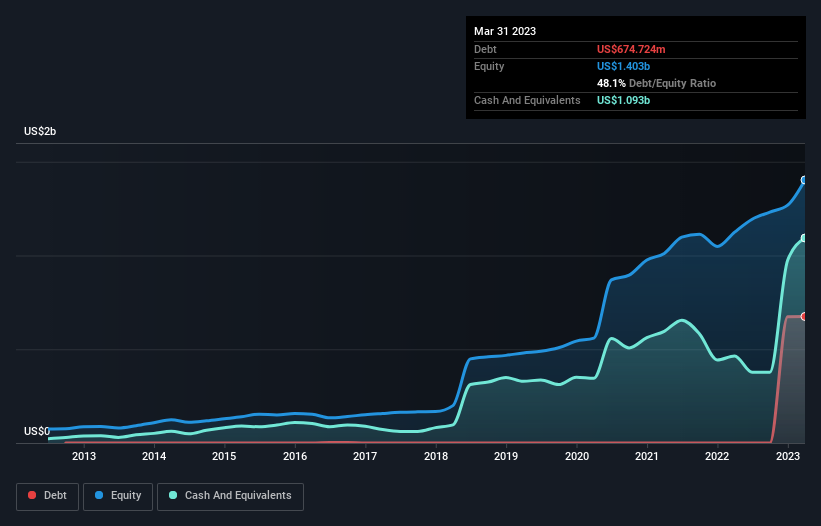- United States
- /
- Aerospace & Defense
- /
- NasdaqGS:AXON
Axon Enterprise (NASDAQ:AXON) Has A Rock Solid Balance Sheet

Howard Marks put it nicely when he said that, rather than worrying about share price volatility, 'The possibility of permanent loss is the risk I worry about... and every practical investor I know worries about.' So it might be obvious that you need to consider debt, when you think about how risky any given stock is, because too much debt can sink a company. As with many other companies Axon Enterprise, Inc. (NASDAQ:AXON) makes use of debt. But should shareholders be worried about its use of debt?
When Is Debt A Problem?
Debt assists a business until the business has trouble paying it off, either with new capital or with free cash flow. If things get really bad, the lenders can take control of the business. However, a more common (but still painful) scenario is that it has to raise new equity capital at a low price, thus permanently diluting shareholders. Of course, the upside of debt is that it often represents cheap capital, especially when it replaces dilution in a company with the ability to reinvest at high rates of return. The first thing to do when considering how much debt a business uses is to look at its cash and debt together.
Check out our latest analysis for Axon Enterprise
What Is Axon Enterprise's Net Debt?
As you can see below, at the end of March 2023, Axon Enterprise had US$674.7m of debt, up from none a year ago. Click the image for more detail. But it also has US$1.09b in cash to offset that, meaning it has US$418.6m net cash.

How Strong Is Axon Enterprise's Balance Sheet?
We can see from the most recent balance sheet that Axon Enterprise had liabilities of US$616.1m falling due within a year, and liabilities of US$988.8m due beyond that. Offsetting these obligations, it had cash of US$1.09b as well as receivables valued at US$596.8m due within 12 months. So it can boast US$85.2m more liquid assets than total liabilities.
This state of affairs indicates that Axon Enterprise's balance sheet looks quite solid, as its total liabilities are just about equal to its liquid assets. So it's very unlikely that the US$14.3b company is short on cash, but still worth keeping an eye on the balance sheet. Simply put, the fact that Axon Enterprise has more cash than debt is arguably a good indication that it can manage its debt safely.
It was also good to see that despite losing money on the EBIT line last year, Axon Enterprise turned things around in the last 12 months, delivering and EBIT of US$98m. The balance sheet is clearly the area to focus on when you are analysing debt. But ultimately the future profitability of the business will decide if Axon Enterprise can strengthen its balance sheet over time. So if you're focused on the future you can check out this free report showing analyst profit forecasts.
Finally, a business needs free cash flow to pay off debt; accounting profits just don't cut it. While Axon Enterprise has net cash on its balance sheet, it's still worth taking a look at its ability to convert earnings before interest and tax (EBIT) to free cash flow, to help us understand how quickly it is building (or eroding) that cash balance. Over the last year, Axon Enterprise recorded free cash flow worth a fulsome 89% of its EBIT, which is stronger than we'd usually expect. That positions it well to pay down debt if desirable to do so.
Summing Up
While it is always sensible to investigate a company's debt, in this case Axon Enterprise has US$418.6m in net cash and a decent-looking balance sheet. The cherry on top was that in converted 89% of that EBIT to free cash flow, bringing in US$87m. So we don't think Axon Enterprise's use of debt is risky. When analysing debt levels, the balance sheet is the obvious place to start. But ultimately, every company can contain risks that exist outside of the balance sheet. For instance, we've identified 2 warning signs for Axon Enterprise that you should be aware of.
At the end of the day, it's often better to focus on companies that are free from net debt. You can access our special list of such companies (all with a track record of profit growth). It's free.
New: Manage All Your Stock Portfolios in One Place
We've created the ultimate portfolio companion for stock investors, and it's free.
• Connect an unlimited number of Portfolios and see your total in one currency
• Be alerted to new Warning Signs or Risks via email or mobile
• Track the Fair Value of your stocks
Have feedback on this article? Concerned about the content? Get in touch with us directly. Alternatively, email editorial-team (at) simplywallst.com.
This article by Simply Wall St is general in nature. We provide commentary based on historical data and analyst forecasts only using an unbiased methodology and our articles are not intended to be financial advice. It does not constitute a recommendation to buy or sell any stock, and does not take account of your objectives, or your financial situation. We aim to bring you long-term focused analysis driven by fundamental data. Note that our analysis may not factor in the latest price-sensitive company announcements or qualitative material. Simply Wall St has no position in any stocks mentioned.
About NasdaqGS:AXON
Axon Enterprise
Develops, manufactures, and sells conducted energy devices (CEDs) under the TASER brand in the United States and internationally.
High growth potential with excellent balance sheet.


